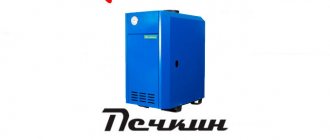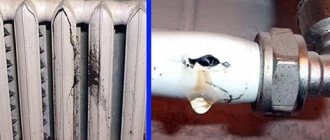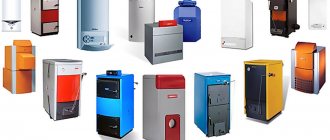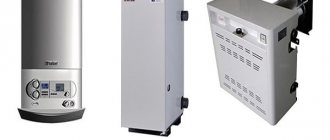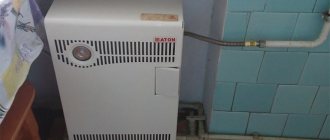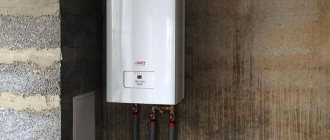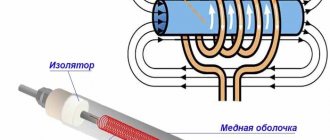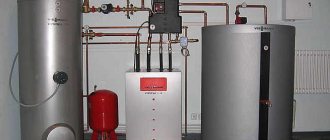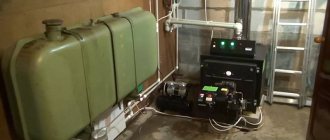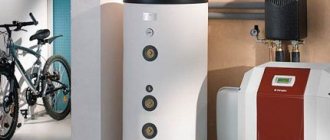To heat their homes, most owners choose an electric boiler. After all, it is not only safer than a gas boiler, but also has a number of advantages compared to other types. It can be used for heating not only a private home, but also any other organizations that need heating in the winter.
Today, electric boilers are in great demand due to the fact that they can be connected almost anywhere. They do not care about the availability of fuel, and they do not pollute the environment.
How does an electric boiler work?
In order to choose the right electric boiler for heating your home, you need to know its characteristics and make sure that they meet the network requirements. Any electric heating boiler for a home includes the following elements:
- Frame. The outer shell, inside which all the boiler parts are assembled;
- Heat exchanger. Heater and container with coolant;
- Control block. Process control, monitoring and regulation system.
Diagram of an electric boiler with a heating element
general information
Conventional household electric boilers for heating are basically simple devices consisting of a powerful (usually up to 24 kW) heater and circulation pump. However, for example, the Russian company Evan produces electric boilers with a capacity of up to 240 kW.
Let's start by dispelling the legends and tearing away the covers.
- An electric heating boiler that uses direct conversion of electrical power into heat is an extremely inefficient device that offers the most expensive method of heating a home. However, it must be admitted that it is one of the most convenient: automatic adjustment, the compactness of the boiler and the absence of combustion products are undoubted advantages.
- One of the frequent search queries is “economical electric heating boilers.” The very fact of its existence makes us mourn the current education system. The fact is that in any heating device the efficiency is 100 percent. ALL wasted electricity is completely converted into heat inside the house. Even the one that goes to maintaining the operation of the circulation pump. Economical electric boilers for heating are a myth that benefits exclusively their sellers.
- At the same time, in terms of the efficiency of heating the room, different heating systems with electric boilers for heating private houses may differ, and quite significantly. The reason is that heat can be distributed inside the house in different ways. A boiler located in the basement will be clearly less efficient than a boiler in a room: part of the heat is lost on its body without being transferred to the coolant.
If placed in a separate boiler room, the boiler and boiler will uselessly dissipate 100-200 kW/h monthly.
Water-heated floors will be much more effective than radiators: the temperature in the room will be distributed more rationally, and hot air will not accumulate uselessly under the ceiling. A programmable boiler can warm up your home when a lower nightly electricity rate is in effect.
Finally, simply reducing the average room temperature by 2 degrees results in an average of 20% savings. You just need to think carefully about the placement of heating devices and the direction of convection air flows.
What's in the bottom line?
Advantages of heating with an electric boiler
- The absence of combustion products and generally any influence on the composition of the atmosphere in the house.
- Ease of management. You don’t have to make adjustments, but simply set the required temperature of the coolant or, if you have an external temperature sensor, air.
- Safety. You are not at risk of carbon monoxide poisoning or a gas explosion.
- No need to store fuel. There is no need for a woodpile or coal storage in the yard.
- Easy to install. It is not difficult to connect the boiler to the power supply and heating system with your own hands. For comparison, you cannot put a geothermal heat pump into operation yourself.
Three valves, a filter and a wire from the panel - that’s all the connection is.
The advantages are undeniable; but what is their price?
Disadvantages of electric boilers
The main imperfections of boilers lie at the very basis of the concept of their operation.
- Direct heating of the coolant is a stupid and wasteful use of resources. Heat pumps have been around for decades. Simple redistribution of heat, pumping it from the street is much more profitable: electricity savings will be at least threefold (in the case of using ground-water or water-water pumps, the ratio of thermal efficiency to consumed electricity can reach 6:1).
- Electric heating boilers were invented quite a long time ago, and over the past decades the principle of their operation has changed little. It is based on heating the coolant to transfer heat within the house. However, over time, low-temperature heaters, including ceramic and film, have appeared and become cheap. They allow you to more flexibly control the heating of your home, avoid heat dissipation during its transportation by coolant, and distribute the load across the home’s electrical network.
- Finally, water is usually used as a coolant. If so, the use of an electric boiler for a summer house or country house is questionable: when the boiler is turned off, the radiators and pipes will be defrosted. Heating a dacha with electric convectors or oil heaters does not have this problem.
Convectors are not afraid of frost. In addition, they will evenly distribute the load along the electrical wiring of the house.
conclusions
It is worth distinguishing between heating with electricity and heating with an electric boiler. The first is convenient and often has no alternative. Second... Let's just say: the use of electric boilers has long been no longer the most effective way to heat a home.
How to calculate the power of an electric boiler
Before buying a boiler, you need to calculate the required power. The boiler power must take into account electricity limits. Due to the limitation of electricity supplied by local electrical networks, if consumption exceeds the circuit breaker, the circuit breaker is triggered, and the heating system of the house may be de-energized. Thus, when choosing a boiler power, you should be guided by calculations and not exceed it.
A limitation may be the cross-sectional area of the supply electrical cable. When choosing a single-phase or three-phase boiler, it is necessary to check that the power of the equipment matches the cross-section of the installed cable. In addition, boilers with constant and variable (modulated) power are offered on the market. The former are more preferable because they cannot allow excess electricity consumption.
An approximate calculation of power takes into account the area of all heated rooms in the house and is done according to the formula: M = P x Where. / 10m2
where M is the power of the electric boiler (kW);
P – area of heated premises;
Where. – specific boiler power, depending on the region:
- for cold climates Kud. 1.2 – 2.0
- for moderate 1.0 - 1.3
- for southern regions 0.7 – 0.9
As practice shows, to heat a house with an area of 100 m2 in the middle zone, you need an electric boiler with a capacity of at least 100 x 1/10 = 10 kW. In addition to power, heating equipment can be selected according to the area and volume of the house.
How to calculate the power of an electric boiler based on the area of the house
The simplest method for selecting equipment based on the area of the house is based on determining the standard heat loss per meter of heated area. But the standards for small buildings up to 200 sq.m. of heat loss per 1 m2 of area are 0.1 kW. With a house area of 100 m2, the estimated amount of losses will be 0.1 x 100 = 10 kW. Adding 20% to the resulting heat losses (adjustment for abnormal cold), we get 12 kW.
Thus, for a house of 100 m2 you will need an electric boiler with a capacity of 12 kW. Accordingly, for a house with an area of 150 m2, the required boiler power will be: 0.1 x 150 x 1.2 = 18 kW. For a house with an area of 200 m2: 0.1 x 200 x 1.2 = 24 kW
How to calculate the power of an electric boiler by room volume
Calculation of the power of an electric boiler for heating a house by cubic capacity is based on a norm of 4 - 8 Wh of electricity per unit volume. The result of the final calculation depends on the heat losses of the entire house and the specific value of these losses during the season. The additional coefficient in the calculations depends on heat loss through the walls of the house, windows, pipelines laid in cold rooms, etc. The estimated duration of the heating season is 7 months.
What it is?
An electric boiler is a heating device that provides the preparation of coolant for a heating circuit or underfloor heating system.
This is a device that is usually used when it is not possible to supply gas to the house, or to use a boiler of a different design.
This approach is due to high electricity prices and experience in using other heating electrical appliances - kettles, irons, etc. At the same time, modern models can operate in a fairly economical mode, and the absence of other sources of thermal energy (gas, solid or diesel fuel) allows reducing costs to a minimum.
Which electric boiler is the most economical?
The criteria by which heating boilers for a private house using electricity are selected are as follows:
- heating area, on which the boiler power will depend;
- characteristics of the premises;
- equipment prices;
- size and weight of the heating boiler;
- life time;
- boiler efficiency.
We will choose from the following types of electric boilers for heating:
- Induction. The main working unit of such boiler boilers is the inductor. These boilers have great power, but are large in size and high in cost.
- Heating elements. The coolants in such boilers are heated by thermoelectric heaters (TEHs), working with power controllers and temperature sensors. The heating element heats the water, which transfers heat to the room. The disadvantage of such boilers is the deposit of scale, which interferes with normal operation and disables the heating elements.
- Electrode. The most economical boilers are approximately 40% more economical than heating elements. The advantages also include small size, fast heating of water and the absence of scale during operation.
Electric boilers, in addition to the listed types, can also be:
- Wall or floor. Wall-mounted boilers, as a rule, are low-power, and are used for heating country houses;
- Single- and three-phase;
- Single and double circuit.
The final decision on which most economical electric boiler to choose for your home depends on your living conditions. In my opinion, this is an electrode boiler, which is connected to a standard electrical network and uses water or non-freezing liquid as a coolant.
Diagram of the electrode boiler
Operating principle
The operating principle of different types of electric boilers has the main similarity - it increases the temperature of water or other liquid. The differences in the types of equipment lie only in the method of converting electricity into heat.
Boiler with heating element
For boiler equipment with heating elements, an electric current passes through a high resistance wire (tungsten), causing it to heat up.
The resulting heat passes through the quartz sand backfill and the heater body to the water moving inside the boiler tank, then reaching the radiators of the heating systems or the “warm” floor coil.
Electrode boiler
With electrode boilers, everything happens a little differently. A “zero” wire is connected to its cylindrical steel body, and a metal electrode with a connected “phase” is installed inside along the axis.
Inside, with the help of a pump, undistilled water from the heating is forced to move, which is a conductor with a certain electrical resistance. That. When electricity is passed through this liquid, it will heat up. The degree of temperature increase depends only on the duration of exposure to electric current and its strength.
Induction
In an induction boiler, water is heated due to the phenomenon of electromagnetic induction. Electricity is passed through a coil wrapped in wire. At the same time, a metal core is placed inside it. Around the coil so-called eddy currents heating the core array, which in turn is washed by water. This is how the coolant absorbs heat.
Which electric boiler is best for heating a private home?
The popularity of electric boilers is determined by:
- security;
- low cost;
- reliability;
- small in size;
- ease of installation and operation;
- silent operation;
- environmental cleanliness.
To choose and buy the best electric boiler, you need:
- make calculations and determine the required power;
- decide on the type of boiler;
- compare options of the selected type and select the best one.
Let me remind you that before purchasing, you must definitely check the operating mode of the local electrical networks - perhaps the networks will not cope with the required load, and the purchase will be in vain.
When deciding which electric boiler to choose for heating a private home, most consumers choose heating element boilers. They are much cheaper than electrode and induction boilers and are easy to maintain. Judging by customer reviews, the best electric boilers on the Russian market for heating a private home are:
- Polish units “KOSPEL EKCO” with an efficiency of more than 99%. Boilers from this manufacturer are used for radiator heating and can work together with water heaters for hot water supply. The company offers manual models for small rooms, and automatic three-phase models of boilers with a power of more than 50 kW for large rooms. The disadvantage of boilers is typical for heating equipment - scale formation on the heating elements. According to customer reviews, boilers from this manufacturer are very economical and reliable.
- Russian electric boilers are also popular in the domestic market. Boilers of three power levels from this manufacturer operate from a conventional and three-phase network, and, according to customer reviews, are quite reliable.
- Electrode boilers have also proven themselves well. They are more economical than heating elements and allow you to do without thermal elements. The most popular boiler of this group is considered to be the Geyser model, whose power ranges from 9 to 15 kW. Low-power “Ochag” models and large “Vulcan” boilers with a power of up to 50 kW are also known on the market. The disadvantages of such boilers are the risk of electric shock and the mandatory involvement of a specialist to replace the electrodes.
- Induction boilers are represented by Russian models “SAV” from INERA. The price for such equipment is high - from 30 to 160 thousand rubles, which depends on the power (for induction boilers it is 2.5 - 100 kW).
The photo shows a Polish electric boiler “KOSPEL EKCO.R1-6”
Video
https://youtube.com/watch?v=HR5GVdNN5Tk
https://samelectrik.ru/kak-podklyuchit-elektricheskij-kotel-otopleniya.html
https://teplospec.com/elektricheskoe-otoplenie/pravilnaya-ustanovka-elektrokotla-otopleniya-poshagovoe-rukovodstvo-i-instruktsiya-po-montazhu.html
https://remoo.ru/kommunikacii/skhema-otopleniya-2-h-ehtazhnogo-chastnogo-doma
How to properly connect an electric boiler to the heating system
Briefly about how to properly install an electric heating boiler in a private house. To begin installation work, we list the basic safety rules that must be observed:
- When connecting the equipment, the power must be turned off.
- The following distances must be maintained between the boiler and the nearest structural elements of the house: to the wall - at least 5 cm, to the ceiling - at least 80 cm, to the floor at least 50 cm, to the nearest pipe - at least 50 cm.
- The front panel must be freely accessible for maintenance.
- The connection network must be three-phase (380 V) to avoid spontaneous combustion and short-circuiting of the wiring.
- Wire connections must be protected from water and sealed. It is better to protect the cable with corrugation or a cable duct made of self-extinguishing material.
Step 1 - installation of an electric boiler
The floor-standing boiler is installed on a special stand, which is sold complete with the unit. The wall-mounted one is attached to the wall with anchors and dowels. The vertical and horizontal position of the boiler must be accurate - misalignments can lead to failure or premature wear of the equipment.
Step 2 - connecting the boiler to the electrical network
- An electric boiler usually has more power, so it needs to be connected not from an outlet, but from the mains. From the distribution box in the room you need to lay a separate line to the boiler installation site. It is better to hide the cable to protect it from accidental damage.
- The cable cross-section must be selected so that it can reliably withstand high loads. Electric boilers up to 7 kW can be connected to a single-phase network, which, as a rule, was preserved in old Soviet apartments. For small boilers up to 3.5 kW, a separate line is not needed; they can be connected directly to the outlet.
Step 3 - install protection
- A residual current circuit breaker (RCD) and a circuit breaker must be installed on the main panel after connecting the wires to the electric boiler. The purpose of RCDs and circuit breakers is to protect against short circuits and wiring overloads.
- A voltage stabilizer will be needed to prevent the boiler from failing in the event of voltage fluctuations. It is strictly forbidden to use the equipment without grounding. The grounding wire must go from the bus to the boiler body.
Step 4 - starting the boiler
After the wiring is connected, you need to make sure that there are no exposed contacts. All taps, couplings, joints, etc. must be inspected and verified. First, the valves and valves are opened, and then the power supply to the boiler is turned on. Temperature and pressure sensors must operate according to the instructions. In case of obvious deviations from the norm, turn off the boiler and call a licensed specialist.
Connection methods
An electric boiler can be used in different ways:
- in a system with natural coolant circulation;
- in a forced circulation circuit;
- combined method.
The choice of one or another option depends on the model and design features of the heater. Some boilers simply cannot be used in conjunction with a circulation pump, since the water in them is heated not by flow, but by replacement.
This means that heated layers of water leave the container with heating elements (or other heaters), and cooler layers take their place.
There are models where heating is carried out at a sufficient speed so that the forced circulation process can be started. As a rule, these are installations with powerful and numerous heating elements or induction elements.
Electrode models act rather slowly, so if circulation is started in them, it is from the outside. This is a combined method, when the flow movement is organized not in the boiler itself, but with the help of an external circulation pump.
There is another connection option - to the “warm floor” system. This is a low-temperature network of pipelines (loops), where the coolant temperature at the boiler outlet does not exceed 50°. With this combination, considerable savings occur on electricity; it becomes possible to use low-power heaters, which reduces the load on the network.
Expert opinion
Torsunov Pavel Maksimovich
The efficiency of this option is higher than when using film heated floors (the most effective of the independent varieties). The only drawback is the complexity of assembling water structures, as well as the need to use appropriate floor coverings.
It must be taken into account that the power of the unit when connected to a 220 V network is limited to 5 kW. More powerful models require connection to 380 V lines. Taking into account the loss of thermal energy at low circulation speeds, 5 kW is enough to heat approximately 30-40 m2.
If there is a need to save money and get maximum effect, heated floors will be the optimal solution. It does not require high power from the heater and can be divided into a large number of loops to improve efficiency. In addition, low-temperature systems allow you to increase the circulation speed, which will give a smaller difference in the temperatures of the forward and return lines and will allow you to save even more on heating the coolant.
How to make an electric boiler with your own hands
Electric boilers for heating a private house at 220 volts are often made independently - it is not difficult if you have the necessary materials and skills. The simplest boiler is a metal container in which heating elements are installed. Usually they make their own boilers with a power of 6 kW - such equipment is enough to heat a small apartment or country house. A DIY boiler will cost at least half as much as a purchased one. You can make a heating or electrode boiler yourself.
Materials for making a boiler using heating elements
For such a boiler you will need a tank of any shape in which the water will be heated by heating elements. The tank can be made from a 150 mm pipe. For a small boiler, 2-3 heating elements are enough, each costing about $10. Materials:
- steel pipe 150 mm;
- round plates l. 150 mm, 2 pcs.;
- nozzles no less than the contour - 3 pcs.;
- heating elements;
- nuts;
- automatic air vent;
- ball valve
Materials for making an electrode boiler
To make an electrode boiler with your own hands you will need:
- pipe 50 mm;
- steel bar 20 mm;
- flange and coupling with internal thread (2 pcs.);
- any dielectric;
- sealing rubber;
- bolts, nuts.
Detailed manufacturing instructions are presented on many websites on the Internet, so we will not repeat ourselves. There you can also see descriptions and connection diagrams for a simple control unit with a temperature sensor.
Installation rules and requirements
Electric boilers are compact in size, require a minimum of wiring and have a modern design, which allows them to be installed anywhere.
All general requirements are described in the PUE (7th edition). Electric boilers with a power of up to 10 kW do not require approval from the Energonadzor services. However, if you want to install a meter that differentiates electricity consumption by zone of the day, which we recommend doing in order to save money, you will still have to coordinate the installation. For boilers with a power of more than 6 kW, three-phase power supply (380 V) is required; 8-12 kW models can operate from a single-phase (220 V) network, but it will not provide operation at full power.
The choice of installation location for an electric boiler is more extensive than for gas or solid fuel boilers. Electric boilers can be installed in a residential area, for example, a corridor, hallway or kitchen, but keep in mind that in any case you need to run pipelines, wiring, grounding and other communications to it. The installation of an electric boiler in the bathroom and toilet is prohibited.
The requirements for the installation surface are also minimal, it can also be a wooden wall, but in this case it is necessary to insulate the installation site with a layer of non-combustible material (basalt cardboard, xylolite sheet).
Fireproof protective plate when installing an electric boiler on a wooden surface.
Manufacturers also impose requirements on the space around the electric boiler necessary to ensure maintenance and repair. The values differ depending on the model, so before planning the installation location and wiring, you should find them in the operating instructions. Usually this:
- from 0.7 m from above the boiler;
- from 0.5 m on the sides (including to the pipeline) and below;
- from 0.7 m in front of the boiler unit;
- at least 3 cm between the wall and the boiler.
For example, the well-known Bosch Tronic Heat 3500 model requires only 0.6 m from the bottom and 0.2 m from the other sides. Any other additional installation requirements are always described in the operating instructions, which in almost all cases can be found in electronic form.
conclusions
- We recommend choosing an electric boiler from the heating element or electrode type.
- To make the final decision, calculate the required boiler power, taking into account a small margin (+ 10-20%). If you purchase a double-circuit boiler, the calculated power should be at least a quarter greater.
- Imported equipment is much more expensive, but has no fundamental advantages. Inexpensive domestic boilers, cheap to repair and maintain, are not inferior in efficiency to imported models.
Induction boilers
These electric boilers for your own home work thanks to eddy currents that warm the core. An inductive coil is placed in the housing. It also houses the core. Under the influence of current, a magnetic field is formed in the environment of the coil, which creates eddy currents.
Such heaters have been used in the industrial sector for a long time. There they operate at a frequency of approximately 50 Hz. As for domestic boilers, they operate at a frequency of ten to one hundred megahertz. And due to this they are completely silent. The induction electric boiler produces slight vibration, but due to the high frequency the vibration is not felt. By the way, it also protects equipment from scale, preventing particles from settling on heating parts.
The strengths of such boilers:
- The owner can easily install and connect the electric boiler without outside help;
- Long service life without the need for repairs;
- Due to the absence of detachable connections, leaks are completely eliminated;
- You can heat not only water, but also any other liquid;
- Small sizes;
- Self-defense against scale.
Equipment weaknesses:
- The inductor has the potential to become the main source of unwanted magnetic radiation. So it would be better not to neglect the choice of the manufacturing company;
- With similar power, such electric boilers are significantly more expensive than heating boilers.
According to the manufacturers themselves, such boilers are more economical. Compared to heating elements. However, practice says that with the same power level, their output is also approximately the same. They are economical if we only talk about the duration of use.
If you have a strong desire and certain skills, you can make such an electric boiler manually. It will be much more budget-friendly, and in terms of power they are not at all inferior to purchased ones. Although in terms of aesthetics, homemade boilers are inferior to purchased ones.
Some types of boilers and their characteristics
Next, we will consider one of each type of electric boilers. It should be noted that many companies produce several types of boilers. One of these is the company Galan (Russia).
We took this company not for advertising purposes, but because this manufacturer really has a lot of models, so it’s easier to find something to use as an example.
Let's take the average models. Among the heating elements, for example, Galan Geyser Turbo 12 kW.
This boiler has a cylindrical shape and can be used either as a floor-mounted or as a wall-mounted boiler.
The length of this heater is 500 mm, the power is 12 kW, so it is indicated that it is capable of heating a room up to 300 cubic meters, although, as already said, everything depends on the thermal insulation of the room itself.
This model comes with a control unit. It is three-phase, so it operates from a 380 V network.
But the Galan Geyser-9 model can already operate from a 220 and 380 V network.
This model is also very compact, its length is only 360 mm. Its power is 9 kW and can work with a coolant volume of up to 100 liters. The manufacturer indicates that this boiler is capable of heating a room with a volume of up to 340 cubic meters. m.
But this manufacturer does not produce induction boilers. Therefore, we will consider one of the models of the manufacturer SAV PROF series.
Let's look at the parameters of the SAV 5 model.
This boiler has a power of 5 kW. At the same time, it is capable of heating a room with a volume of up to 200 cubic meters. It operates from a 220 V network, and as for its size, it cannot be called small, its height is 640 mm with a width of 455 mm.
Popular among readers: Are infrared heaters worth buying?
Reviews of economical household electric boilers: advantages and disadvantages
| Advantages | Flaws |
| Compact sizes. Models with a steel square case are much smaller than gas models. Electrode boilers can be slightly larger than the main heating system in the house. | High energy consumption and, as a result, the most expensive heating costs. Therefore, even the most energy-saving boilers can hardly be called economical. According to practice and reviews from owners, heating even a small house with an area of 80 m2 with electricity costs 9-12 thousand rubles. per month. To use cheap night rates, you need an appropriate meter. |
| High efficiency and heating rate of coolant | Models with a power of more than 5-6 kW require a three-phase power supply (380 V). |
| Easy to install and operate. You can install an electric boiler without any special skills; moreover, it does not require a chimney, ventilation system, or boiler room. Operation and maintenance require minimal attention. | When used as the main heating equipment, it is completely dependent on power supply. For stable operation in domestic conditions, a stabilizer and a UPS or generator are desirable |
| Electric boilers are absolutely environmentally friendly because, unlike other types, they do not emit any substances during operation | Powerful models create a significant load on the electrical network of the house. Therefore, they require high-quality and serviceable wiring. |
| Absolutely silent operation | |
| Availability of both single-circuit and double-circuit models (providing heating and hot water supply). Many models can be used in underfloor heating systems. | |
| Extremely low cost of most models |
Power calculation
In order for electric boilers for a private home to heat it at the proper level and maintain a comfortable temperature, before you decide to purchase a boiler, it would be a good idea to calculate the power parameters.
The approximate formula is as follows: calculate the total area of the house and divide the resulting number by ten. The final result will be the lower power threshold in kilowatts. For example, the total area of the house is 95 square meters. Divide by ten, and it turns out that the approximate power of the boiler is 9.5 kilowatts.
But at the same time, it is necessary to choose an electric boiler with a little more power. For example, twelve kilowatts. However, even this level of power will not be enough for the northern regions of the country, where temperatures drop very low in winter. And therefore, auxiliary sources of heating will not be superfluous. After all, the boiler will not “plow” during the entire heating season at maximum power.
If installed correctly, it will operate in heating mode or at partial load most of the time. Therefore, it would be incorrect to calculate expenses for light based on the maximum power of the electric boiler.

